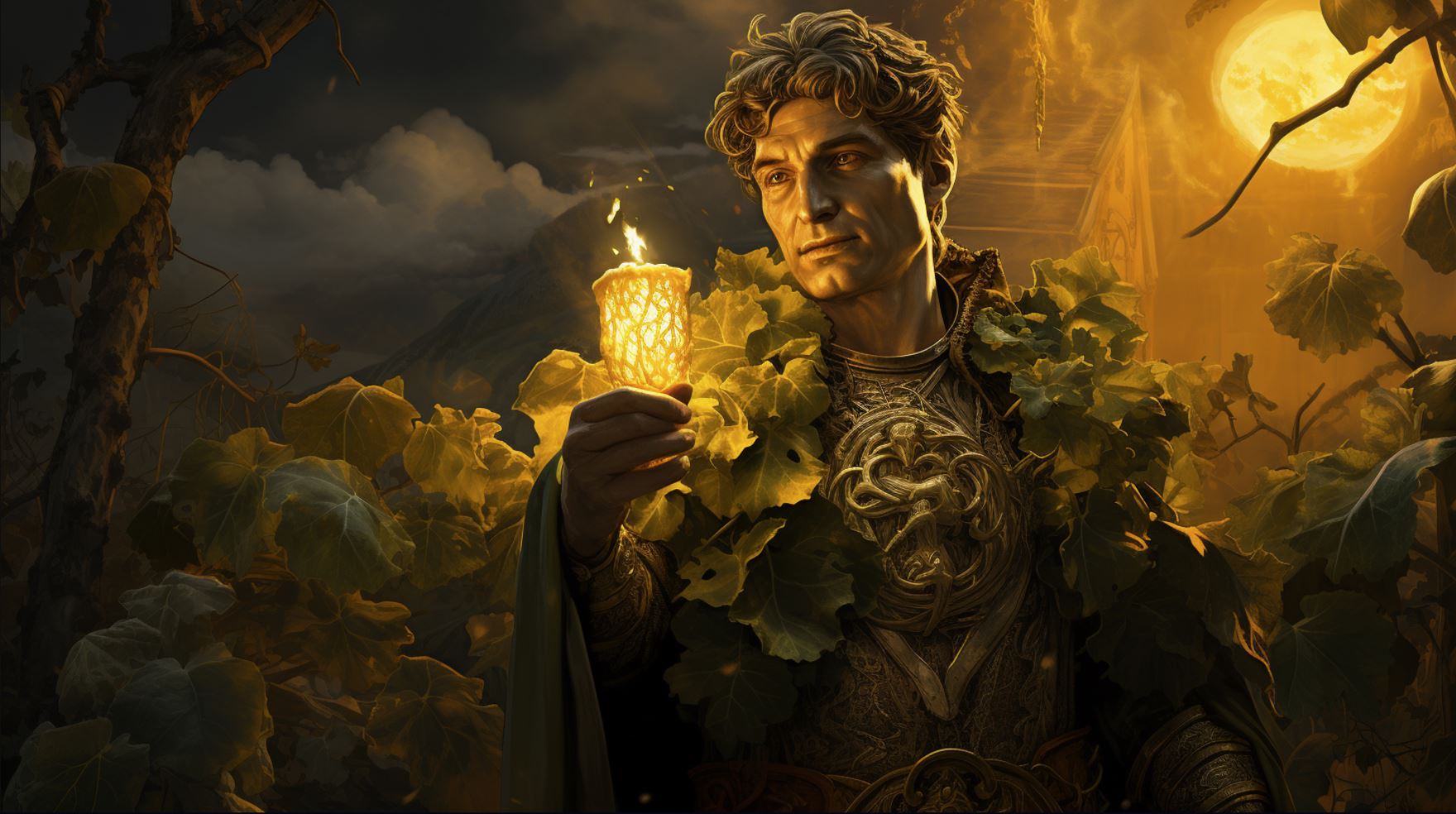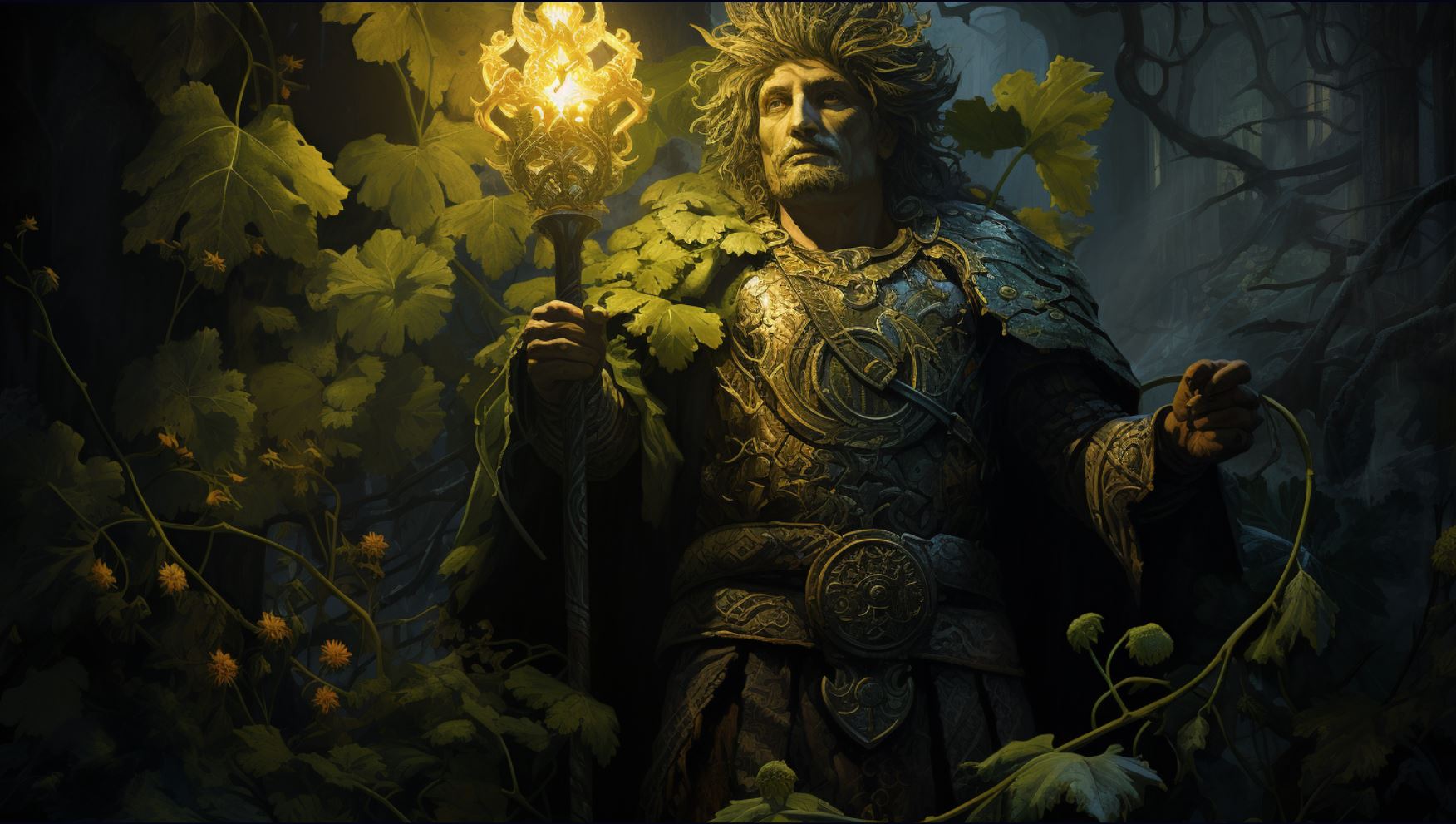Belenus: The Celtic God of Fire and Light

Belenus, known also as the Celtic god of fire, an ancient deity worshipped across Celtic regions, holds significant historical and cultural importance. This divine figure, whose personal name might be connected with divine names of radiance and healing, embodies the essence of brightness and brilliance, marking him as a key figure in celebrating renewal and fertility.
The deity, often associated with pastoralism and the Beltane festival, symbolizes the fire’s transformative power and the sun’s radiant energy. Furthermore, the place name of his prominent sanctuary in Aquileia suggests that Belenus’s worship, stretching from the Italian peninsula to the British Isles, may have been interwoven with the worship of other deities, possibly indicating more different names and forms of this versatile god.
During the Roman period, Belenus was identified with Apollo, expanding his worship even more and perhaps connecting with the cults of third-century emperors Diocletian and Maximian, each of whom sought divine favor in turbulent times.
Noricum inscriptions dedicated to Belenus sometimes show a syncretism with the Roman pantheon, suggesting a complex interplay of divine names and attributes.
Explore the depth of Belenus’s legacy, the Celtic god of fire, and unravel the mysteries surrounding this revered figure in Celtic mythology.
Who is Belenus?
Belenus, an ancient Celtic deity revered for his enigmatic qualities and influential impact on Celtic culture across various regions, stands as a testament to the power of divine names in shaping religious and cultural identities.
His role as the Scottish god of fire and his association with divine entities like Manannan Mac Lir enrich our understanding of the interconnectedness of Celtic deities.
In this section, we delve into the origins and characteristics of Belenus, shedding light on his importance in the Celtic pantheon and exploring how the personal name and place name connected with his worship reflect the widespread adoration he enjoyed.
Belenus: An Ancient Celtic Deity
The name of Belenus, shining bright across different Celtic regions, may have been derived from older, divine names signifying ‘bright’ or ‘resplendent.’ This connection with brightness aligns with Belenus’s attributes in Celtic mythology, embodying him as the bright and shining one, often equated with the sun itself.
His worship, extending from the Italian peninsula to the British Isles, showcases the deity’s far-reaching influence. The place name of Aquileia, where his primary sanctuary was located, along with concordia and Iulium, further illustrates the geographical spread and the rich tapestry of stories connected with Belenus.
The Worship and Spread of Belenus across Celtic Regions
The worship of Belenus intersected with pastoralism, reflecting his association with fertility and abundance. This divine figure embodies the vitality of nature and the bountiful blessings bestowed upon Celtic tribes.
His connection with the festival of Beltane, a celebration of fire and renewal, alongside the medicinal properties of the henbane plant, further highlights his importance in Celtic festivities and his role as a healer and protector.
These symbols and associations, including the horse and wheel, represented the power and energy present in Celtic society and the natural world, tied closely to Belenus’s divine presence. Exploring the stories and worship associated with Belenus opens a gateway to understanding the rich tapestry of Celtic mythology, revealing a complex panorama of divine names, personal names, and the places sacred to his followers.
Belenus in Mythology and Iconography
Exploring the mythology and iconography of Belenus provides insights into the significance and representation of this ancient Celtic deity. He is often associated with various symbolic elements that showcase his importance in Celtic culture.
The intricate relationship between Belenus and symbols like the horse and wheel highlights his role as a divine figure influencing various aspects of life, cementing his status as a protector of the tribes that worshipped him.
Belenus and his Associative Symbols
Significant symbols connected to Belenus, such as the horse and wheel, embody the intricate relationship between the divine and natural world in Celtic myth and legend. As the Gaulish deity whose worship was widespread, Belenus’s presence from Britain and Ireland to the broader Celtic world symbolizes the god’s far-reaching influence, demonstrating the enduring legacy of Celtic deities and their complex pantheon.
Explore the rich tapestry of celebrations and festivals associated with Belenus, the revered Celtic god. These festivities offer insights into the cultural significance and worship practices surrounding Belenus across Celtic regions.
Beltane: The Festival Associated with Belenus
Beltane, a prominent festival in Celtic lore, is deeply intertwined with the worship of Belenus. Held on the eve of May 1st, this ancient celebration marks the arrival of summer and is considered one of the most important in the Celtic calendar.
It is believed that Belenus played a central role in this festival, which focused on fire rituals, fertility, and the ushering in of prosperity, embodying the spirit of the Celtic fire god.
- Fire was a key element during Beltane, symbolizing purification and transformation. Communities would gather around bonfires and leap over the flames for good fortune and protection, invoking the energy of Belenus.
- As a deity associated with the sun’s radiance, Belenus’ presence was especially honored during Beltane, with offerings and prayers dedicated to him, affirming his identity as the Celtic sun god.
- Maypole dances, a popular tradition during Beltane, also held symbolic significance in connection to Belenus.
The dance around the decorated pole represented the growth and vitality associated with the Celtic god.
Saint Bonnet: A Festivity Linked to Belenus
Saint Bonnet, a feast day celebrated on the 15th of May, is believed to have connections to Belenus. In some Celtic communities, this particular festivity became intertwined with the worship of the ancient god, reflecting the enduring legacy of Belenus into the later 4th century and beyond.
- During Saint Bonnet, locals would gather in sacred groves or near ancient monuments associated with Belenus to honor their heritage and pay tribute to the deity, showcasing the god’s significance in both the spiritual and physical landscape of the Celts.
- Ceremonies often involved processions, music, and communal feasting as a way to express devotion to Belenus and seek blessings for the year ahead, demonstrating the community’s deep-rooted connection with the deity.
- Offerings of flowers, herbs, and other natural elements were made at Belenus’ sacred sites during Saint Bonnet, representing gratitude and seeking favors from the deity.
These celebrations and festivals provide a glimpse into the fervent adoration and vibrant traditions tied to the worship of Belenus, underscoring his enduring significance in Celtic culture and religious practices.
Belenus’ Medicinal Associations
Explore the intriguing connections between Belenus Celtic myth and legend and the world of herbal medicine. In this section, we delve into the plant associated with Belenus, known as henbane, and uncover its potential healing and medicinal properties, illustrating the diverse aspects of Belenus’s worship and his association with health and healing.
Henbane: The Plant Linked to Belenus
One of the notable associations with Belenus is the plant known as henbane. Henbane, scientifically known as Hyoscyamus niger, is a herbaceous plant that has played a significant role in Celtic folklore and natural medicine, and its connection to Belenus highlights the god’s role as a healer within the Celtic world.
Throughout the Celtic regions, henbane was considered a sacred plant closely tied to the worship of Belenus.
- Appearance: Henbane features large, ovate-shaped leaves and bell-shaped yellow flowers, with its seeds enclosed in prickly pods.
- Cultural Significance: The ancient Celts regarded henbane as a sacred plant closely tied to the worship of Belenus.
It held a position of reverence in rituals and ceremonies, emphasizing the plant’s medicinal and symbolic importance.
- Belenus and Henbane: The name Belenus may be derived from the name of the plant henbane, further emphasizing the deity’s association with healing and herbal medicine.
Belenus’s Healing and Medicinal Properties
Besides its symbolic importance, henbane was valued for its potential medicinal properties.
The ancient Celts believed in the healing abilities of this plant, which contributed to its association with Belenus. This association underscores the intricate interplay between spirituality and medicine in Celtic culture, reflecting the ancient Celts’ profound understanding and utilization of nature’s remedies.
- Medicinal Uses: Henbane was utilized in Celtic herbal medicine to treat various ailments, such as respiratory issues, pain relief, and even as a sedative.
- Cautionary Note: Despite its medicinal applications, henbane contains potent alkaloids that can be toxic if not used properly.
This reinforces the importance of expert guidance and caution when working with this plant.
Exploring Belenus’s medicinal associations sheds light on the ancient Celts’ profound understanding and utilization of nature’s remedies.
The link between Belenus, henbane, and healing showcases the intricate interplay between spirituality and medicine in Celtic culture.
Belenus and His Identification with Apollo
As the cult of Belenus expanded during the Roman period, he became increasingly associated with the well-known Roman god Apollo. This identification with Apollo was likely influenced by the similarities between the two deities, such as their association with the sun and their roles in healing and medicine.
The shining one, Belenus, was associated with the sun, representing warmth, light, and vitality, akin to Apollo’s attributes.
Belenus during the Roman Period
During the Roman period, Belenus gained recognition and popularity beyond the Celtic regions, extending his worship throughout the Roman Empire. Inscriptions dedicated to Belenus were discovered in regions beyond the eastern Alps, demonstrating his widespread veneration.
As a result, Belenus was equated with Apollo, the Roman god of light, healing, and prophecy, reflecting the cultural assimilation between Celtic and Roman traditions.
Belenus’s Cult and Association with Apollo
The connection between Belenus and Apollo was further solidified through the spread of Belenus’s cult across the Roman Empire.
Temples dedicated to Belenus were often built alongside temples of Apollo, emphasizing the perceived connection between the two gods. This association extended to their respective domains, with both deities highly regarded for their healing abilities and worshipped for their power to cure ailments and bring fertility to the land.
In addition to their shared attributes, Belenus’s cult and worship practices were also influenced by Roman traditions surrounding Apollo. The rituals and festivals dedicated to Belenus mirrored those of Apollo, further strengthening the assimilation of the two deities.
Despite the identification with Apollo, Belenus still retained his distinct Celtic characteristics, and his connection to the Celtic people remained strong.
- The identification of Belenus with Apollo reflected the cultural assimilation between Celtic and Roman traditions, showcasing the complexities of religious syncretism.
- Belenus’s cult expanded beyond Celtic regions and gained popularity during the Roman period, indicating the deity’s enduring appeal.
- Temples dedicated to Belenus were often found alongside temples of Apollo, emphasizing their association.
- Belenus and Apollo were both revered for their healing abilities and association with the sun.
- Rituals and festivals in honor of Belenus incorporated Roman traditions surrounding Apollo.
- The cult of Belenus retained its distinct Celtic characteristics despite the identification with Apollo.
Exploring the connection between Belenus and Apollo offers valuable insights into the religious and cultural interactions of ancient Celtic and Roman societies, shedding light on the complexities of religious syncretism during this time.
Belenus Celtic God: Legacy and Significance
Discover the lasting impact and profound significance of Belenus Celtic God on Celtic culture and society. This ancient deity has left a remarkable imprint across various domains.
Belenus’ Impact on Celtic Culture and Society
Belenus, the shining god and Celtic deity, permeated every aspect of Celtic culture and society, leaving an indelible mark on their beliefs, traditions, and way of life.
His worship was prevalent in multiple regions, including Italy, Noricum, Gaul, Brittany, Ireland, and even as far as ancient Gaul and Gallia Cisalpina, showcasing his role as a national god in these areas.
The enduring devotion to Belenus is extraordinary, as evidenced by the multitude of dedications and inscriptions found throughout Celtic territories, making him one of the most ancient and most widely worshipped deities.
This deity’s influence reached beyond religious practices. Belenus’ association with pastoralism resonated deeply with the Celtic people, as they depended on agriculture and animal husbandry for sustenance and livelihood. The festival of fire, Beltane, which is believed to be connected to Belenus’ cult, exemplified the importance of nature and the changing seasons in Celtic society, reinforcing his status as the Belenus Celtic sun god.
Moreover, Belenus, often identified with the goddess Belisama as a counterpart, played a crucial role in the healing arts and herbal medicine, embodying peace and healing. The henbane plant, closely linked to Belenus, possessed medicinal properties and was utilized for various treatments.
The reverence for Belenus extended into the realm of healthcare, highlighting the intricate balance between spirituality and practicality in Celtic civilization.
The Importance and Popularity of Belenus’ Cult
The significance of Belenus’ cult cannot be overstated. Its widespread popularity is evident in the numerous dedicatory inscriptions and artifacts discovered in Belenus’ main sanctuary in Aquileia and other regions throughout the Celtic world, from the Alps and Gallia to Britain and Ireland.
The devotion to Belenus transcended geographical boundaries, echoing his reputation as the god who became more integrated into the fabric of ancient society over time.
Belenus’ association with the sun, and his status as a radiant and luminous deity, further contributed to the cult’s allure and appeal.
The Celts revered Belenus as a symbol of enlightenment and brilliance, fostering a sense of unity and cohesion within Celtic communities. His symbols, such as the horse and wheel, offer a glimpse into the beliefs and values associated with Belenus in Celtic culture.
During the Roman period, the identification of Belenus with the Greco-Roman god Apollo, and Britain Apollo syncretism, expanded the reach and influence of Belenus’ cult. Herodian mentions Belenus, highlighting his integration within Roman society, particularly during the third century under emperors like Maximian each acknowledging the divine.
This historical context demonstrates the evolution of Belenus from a regional to a widely venerated deity.
Today, the legacy of Belenus, also known as Bel or Beleneus in some historical texts, endures, as scholars and enthusiasts continue to explore the mysteries surrounding this revered figure in Celtic mythology.
The impact of Belenus on Celtic culture and society serves as a testament to the deep-rooted spirituality and rich traditions of the ancient Celts.
Unveiling Belenus: Understanding the Ancient Celtic God
Belenus, the enigmatic deity of the Celtic pantheon, fascinates scholars and enthusiasts alike.
Exploring the depths of Celtic mythology allows us to shed light on this mysterious figure and unravel the significance of Belenus in ancient beliefs and practices.
Among the ancient Celtic deities, Belenus holds a special place, revered across multiple regions from ancient Gaul to Britain.
His origins, rooted in the root bel, meaning bright or shining, and attributes have intrigued researchers for centuries. By delving into the historical records and archaeological findings, we gain a deeper understanding of Belenus and his role in Celtic society.
As we delve into Belenus’ identity, we encounter a diverse array of myths and iconography associated with this revered god. Symbolism, including the Belenus symbol, plays a crucial role in understanding his character and significance.
The horse and wheel, often considered as his symbols, offer a glimpse into the beliefs and values associated with Belenus in Celtic culture, further illuminating his multifaceted role as both a protector and a guide for the Celts.
Within the rich tapestry of Celtic mythology, Belenus, the Bel Celtic god, finds connections with other deities, sparking intriguing debates among scholars. Known for his bright and shining presence, the Belenus meaning encompasses the sun’s power and the fire’s transformative energy, making him one of the most widely worshipped deities in ancient times.
Belenus’ presence is not limited to myths and legends alone. His influence extends into the realm of festivals and celebrations, where he presides over significant events. The Beltane festival, closely associated with Belenus, embraces the change of seasons and the eternal cycle of life, marking him as a central figure in the celebration of spring’s arrival.
This festival’s significance underscores evidence that the popularity of Belenus spread from Gallia Cisalpina, throughout Celtic regions in Gaul and Britain, and beyond, highlighting the god’s extensive reach.
Another festivity, Saint Bonnet, intertwines pagan and Christian traditions, with echoes of Belenus’ ancient worship still resonating today.
This blend of practices suggests that the god Belenus became more widespread during the Roman period, adapting and integrating into various cultural contexts, thus underlining his flexibility and enduring appeal across different cultures and epochs.
The medicinal properties of the henbane plant further emphasize Belenus’ multifaceted nature. Associated with healing and restoration, Belenus emerges as a deity with a nuanced presence in both spiritual and practical aspects of Celtic life.
The areas where inscriptions dedicated to Belenus are concentrated, particularly around the eastern Alps and extending into regions that were part of the Roman Empire, show the geographical spread of his cult and its significance in ancient healthcare practices.
The Belenus god symbol, often associated with healing, reflects his deep connection to both the celestial and the earthly realms.
With the onset of the Roman period, Belenus found himself linked with the influential deity Apollo. This fusion of beliefs resulted in the identification of Belenus with Apollo, further expanding the reach and influence of his worship.
The third century emperors, such as Maximinus Thrax who revered Apollo, may have contributed to integrating the worship of Belenus into the broader Roman religious landscape, indicating a blend of Celtic and Roman religious practices.
Belenus, the Celtic Sun God, with his enigmatic persona and enduring cult, leaves an indelible mark on Celtic culture and society. His importance cannot be understated, as evidenced by the widespread dedications and sanctuaries throughout regions in Gaul and Britain.
Unveiling the depths of Belenus’ legacy allows us to appreciate the intricate tapestry of ancient Celtic beliefs and their enduring significance in our world. The alliance with his cult and the association with other deities, such as Manannan Mac Lir, further illustrate the complexity and richness of the pantheon to which Belenus belonged, cementing his status as possibly the most ancient and revered deity within certain Celtic communities.
.




















